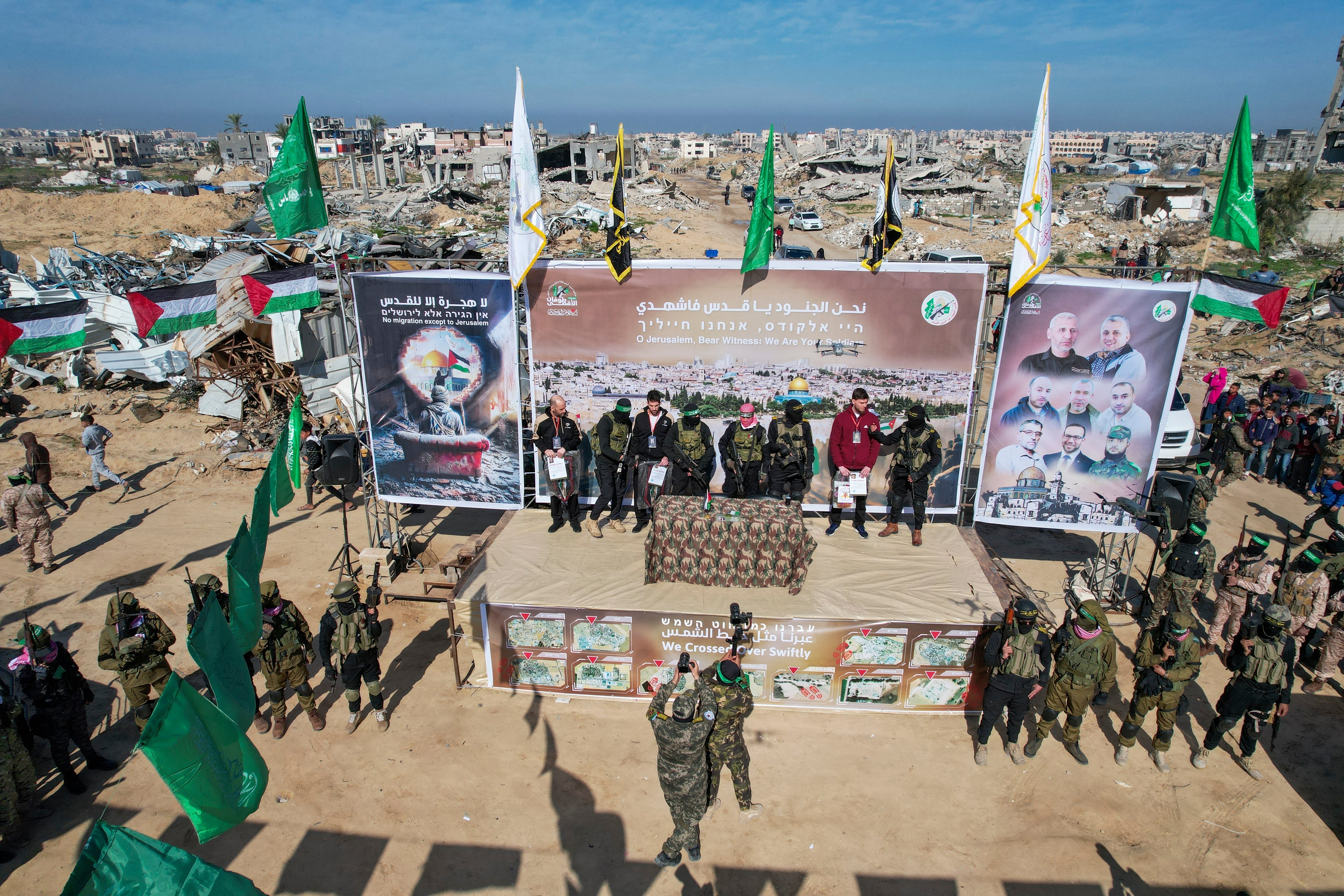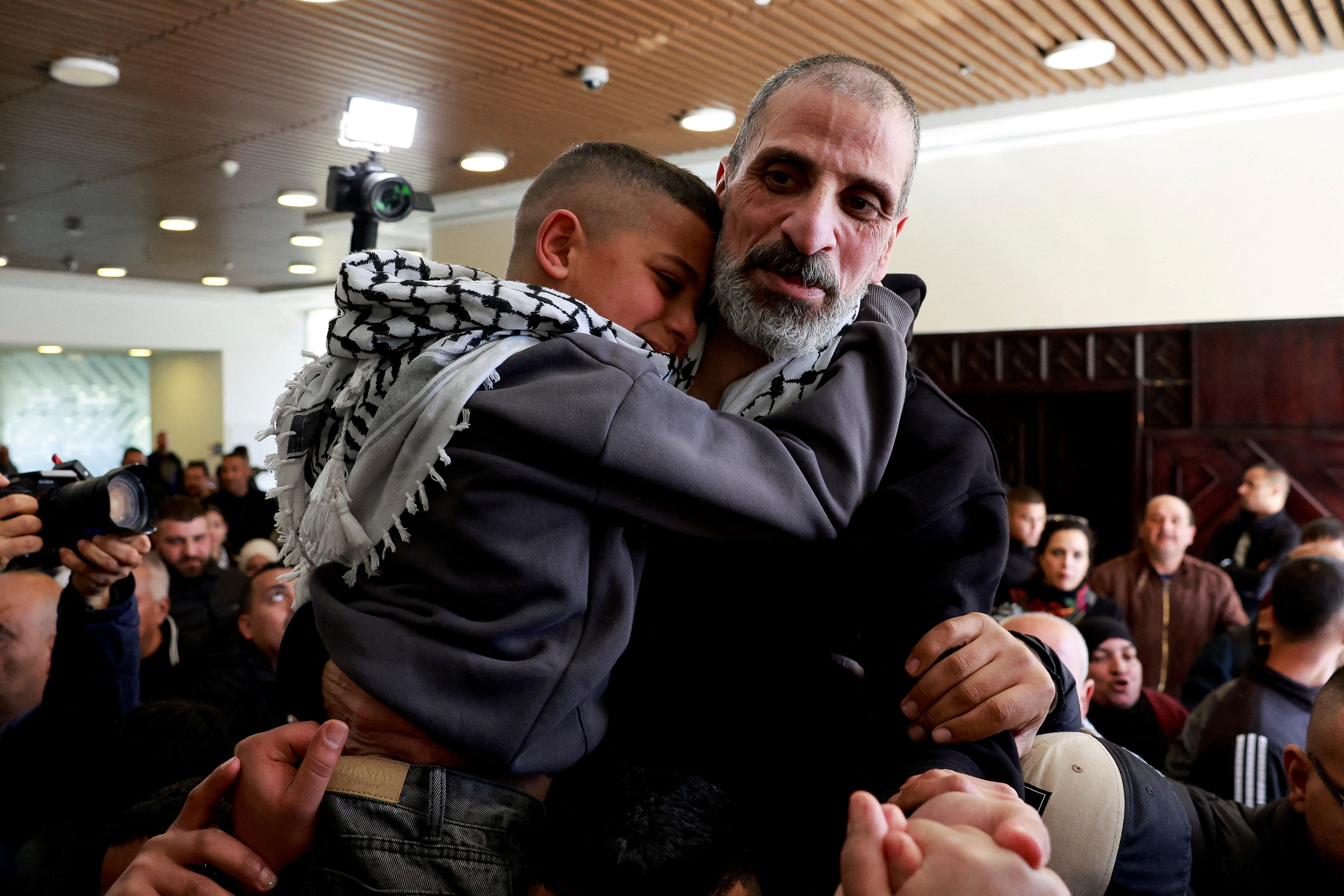Everything we know about the Gaza ceasefire deal and what happens next
Fears rise of resumption of war in Gaza over demands for Israeli hostages to be returned on Saturday
A fragile ceasefire deal struck between Israel and Hamas went ahead on Saturday after teetering on the brink of collapse this week.
Since the ceasefire and hostage deal came into force on 19 January, both sides have expressed frustration with how the other has handled their obligations within the truce.
Despite this, the deal has held so far. Exactly 24 hostages have been released in total, including 19 Israelis and five Thai nationals, in exchange for hundreds of Palestinian prisoners and detainees. Many prisoners are incarcerated without charge or trial under an Israeli process called administrative detention.
But after Hamas alleged that Israel had breached the terms of the fragile ceasefire and subsequently suspended the handover of hostage this week, the deal came close to collapse.

Netanyahu said he had also ordered the military to gather forces in and around Gaza as Israel warned it would open the “gates of hell” on Gaza if hostages were not released by noon on Saturday.
On Thursday, Hamas announced would continue implementing the ceasefire as originally planned, before Russian-Israeli Sasha Troufanov, 29, Argentinian-Israeli Iair Horn, 46, and US citizen Sagui Dekel Chen, 36, who were all seized from Kibbutz Nir Oz, were all released on Saturday. In exchange, Israel freed 369 Palestinian prisoners and detainees.
The stand-off threatened to reignite a conflict which started when Hamas killed around 1,200 people in a terror attack on southern Israel on 7 October 2023, and abducted another 250.
In response, Israel launched a devastating bombing and ground campaign in Gaza, killing more than 46,000 Palestinians, according to Gaza’s health ministry.
Why did Israel threaten to end its ceasefire with Hamas?
Under the ceasefire deal signed on 19 January, Hamas has so far freed 24 Israeli hostages. They are being exchanged for hundreds of Palestinian prisoners and detainees in the first stage of the multi-phase ceasefire deal.
Mediators hope a second phase of the agreement will lead to the release of the remaining hostages and the full withdrawal of Israeli troops from Gaza. However, talks in Doha broke down on Monday when the Israeli team returned home just two days after arriving.
This week, Hamas announced it would suspend the handover of hostages due to alleged Israeli violations of the ceasefire terms.
In response, Mr Trump demanded all hostages be released on Saturday at noon, before Mr Netanyahu warned of a return to “intense fighting” if more hostages were freed on Saturday, without saying how many.
Israel later threatened to “open the gates of hell”, and to start a “new Gaza war… different in intensity”, if all hostages were not released by Saturday noon. It deployed additional troops to its border area with Gaza and cancelled leave for combat soldiers.
Mr Netanyahu is under pressure in his country where thousands of protesters took to the streets this week to call on the government to continue with the ceasefire deal to bring the remaining hostages back.

Why did Hamas nearly pause the hostage exchange?
Earlier this week, Abu Obeida, spokesman for the armed wing of Hamas, announced the postponement of Saturday’s planned release of three Israeli hostages.
The group has accused Israel of delaying the return of Palestinians to northern Gaza, carrying out strikes across the enclave and hindering the entry of humanitarian aid. On Wednesday, Israeli military said it had struck two people in the southern Gaza Strip who were flying a drone.
Gaza's health ministry said at least 92 Palestinians have been killed and more than 800 wounded by Israeli fire since the ceasefire deal.
Hamas has said the "door remains open" to the exchange going ahead on Saturday if Israel "complies" with its obligations, according to news agency AFP.
Three Israeli officials and two mediators told the New York Times on condition of anonymity that Hamas’ claims were accurate. But COGAT, the Israeli military unit overseeing aid deliveries, described the accusations as “completely false”.
But Hamas has now called off the pause in hostage exchanges after Israel’s threat to unleash a new war on Gaza. The militant group said mediators had pledged to "remove all hurdles" to ensure Israel would allow more tents, medical supplies and other essentials into Gaza.
What is in the first phase of the ceasefire?
A six-week initial ceasefire phase includes the gradual withdrawal of Israeli forces from central Gaza and the return of displaced Palestinians to northern Gaza.
Hamas will release 33 Israeli hostages, including all women (soldiers and civilians), children, and men over 50. Hamas will release female hostages and under 19s first, followed by men over 50.
So far, 24 hostages have been released, including 19 Israeli and five Thai hostages.
In return, hundreds of Palestinian prisoners and detainees have been freed from Israeli prisoners. Thousands of Palestinians are currently imprisoned in Israel without charge under a policy known as “administrative detention”, but it is unclear whether they have ben involved in the prisoner releases.
Israeli troops would also pull out of all populated areas of Gaza during the first stage while “the Palestinians [could] also return to their neighbourhoods in all the areas of Gaza”, said former US president Joe Biden at the time of the deal being signed.
The agreement also stipulates that aid deliveries to Gaza should rise to 600 trucks daily, surpassing the minimum requirement of 500 trucks that aid agencies deem necessary to address the territory’s dire humanitarian crisis.
What is the second phase of the ceasefire?
Negotiations over a second phase of the agreement appear to have broken down after an Israeli team returned from talks in Doha after two days.
It is hoped it will include the release of all remaining hostages, including Israeli male soldiers, a permanent ceasefire and the complete withdrawal of Israeli soldiers.
The second and most difficult phase will mark “a permanent end to the war,” president Biden said.
It will include the release of all remaining living hostages, including male soldiers, and Israeli forces would withdraw completely from Gaza.
Hamas said it will not release the remaining captives without a lasting ceasefire and a full Israeli withdrawal.
What is the third phase of the ceasefire?
The third and final stage would involve the reconstruction of Gaza – something which could take years – and the return of any remaining hostages’ bodies.
The deal requires 600 truckloads of humanitarian aid to be allowed into Gaza every day of the ceasefire, 50 of them carrying fuel, and 300 of the trucks allocated to the north of the strip.
Israel allows aid into the enclave but there have been disputes over the amount allowed in, as well as the amount that reaches people in need, with looting by criminal gangs an increasing problem.
What next for Gaza?
As uncertainty hangs over the current ceasefire, it’s still not clear what will happen and who will manage Gaza if the truce deal is completed.
Israel has said it will not end the war leaving Hamas in power. It has also rejected the administration of Gaza by the Palestinian Authority, the Western-backed body set up under the Oslo interim peace accords.
The international community has said Gaza must be run by Palestinians, but efforts to find alternatives to the main factions among civil society or clan leaders have proved largely fruitless.
Last week, Mr Trump announced a plan for the US to take over Gaza, move out its more than 2 million Palestinian inhabitants and redevelop it into an international beach resort.
But the idea has faced opposition neighbouring countries who claim it could fuel regional instability.



Join our commenting forum
Join thought-provoking conversations, follow other Independent readers and see their replies
4Comments